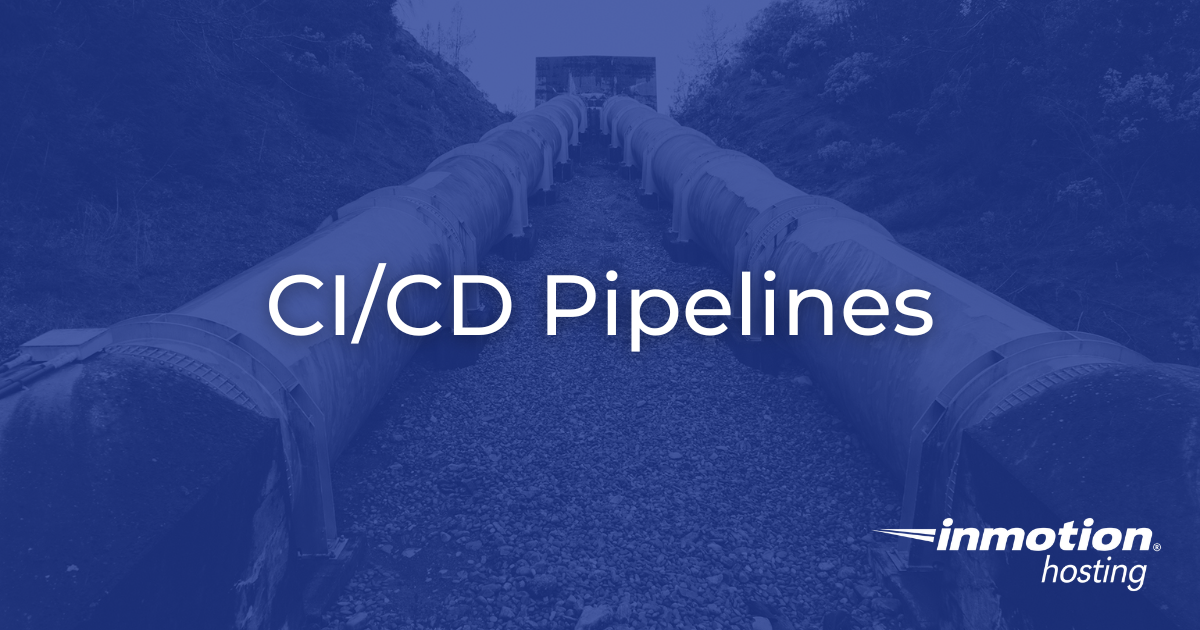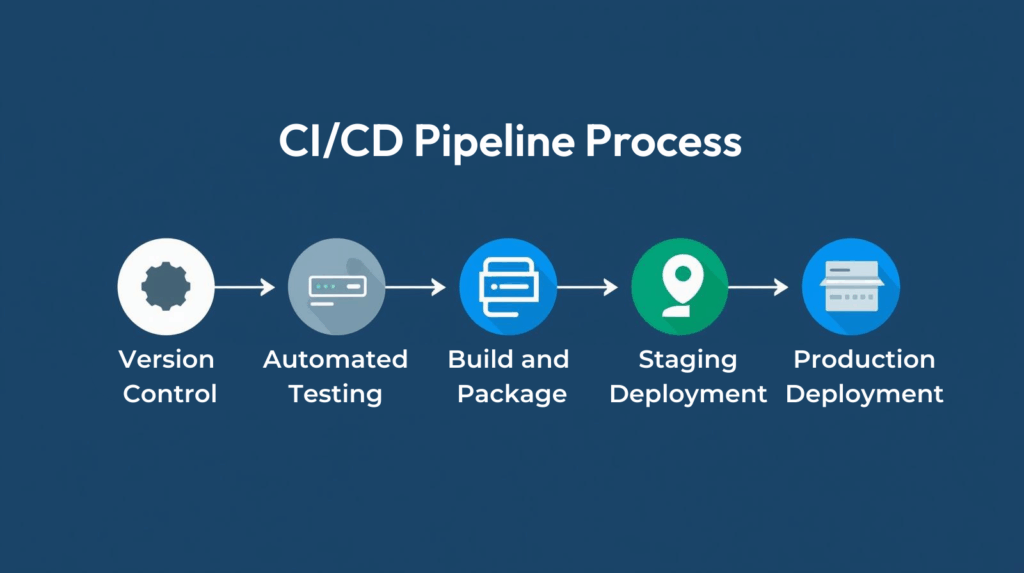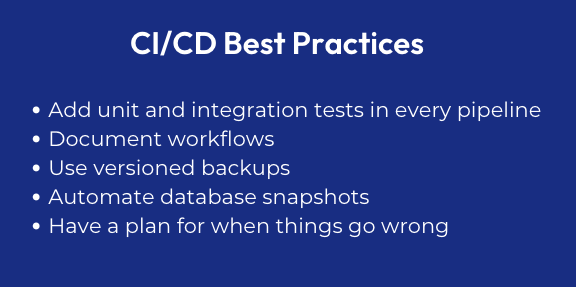CI/CD Pipelines: What Are They and Why Do You Need to Know?

A CI/CD pipeline automates the process of moving code from development to production, ensuring faster, safer, and more reliable updates. By standardizing testing, builds, and deployments, businesses reduce downtime and deliver consistent user experiences. For agencies, marketers, founders, and hosting partners, pipelines unlock agility, scalability, and efficiency. With the right hosting your ci/cd pipeline becomes the engine that fuels growth, reliability, and competitive advantage.
When you update a website or application, you want changes to go live quickly, safely, and without downtime. That’s where CI/CD pipelines come in. CI/CD stands for Continuous Integration and Continuous Delivery (or Deployment), and it’s the process that lets teams release updates faster, with fewer errors, and with less manual effort. For agencies managing multiple clients, in-house marketers launching campaigns, founder-led businesses innovating on the fly, and hosting partners scaling their offerings, CI/CD isn’t just a developer trend, it’s a growth engine.
This guide explains what CI/CD pipelines are, why they matter to your business, and how they work. It will also delve into the fundamentals required for reliable CI/CD workflows, all of which rely on a secure, robust web hosting environment.
What is a CI/CD Pipeline?
A CI/CD pipeline is an automated workflow that takes your code from development to production. It ensures that updates are tested, packaged, and deployed in a repeatable, reliable way, removing the need for manual uploads and ad hoc testing. The pipeline standardizes every step of the release process, removing guesswork and reducing human error.
- Continuous Integration (CI): Developers merge code changes into a shared repository on a frequent basis. Automated tests run to catch issues early, so bugs don’t build up and break the project later.
- Continuous Delivery/Deployment (CD): Once changes pass testing, they automatically flow to staging or production environments. This ensures updates reach end users faster and with less risk.
Think of it as an assembly line for your website or app. Instead of manually copying files, running tests by hand, and hoping nothing breaks, you define the steps once, and the pipeline runs them every time. For businesses, this automation means less downtime, more consistent user experiences, and faster iteration cycles.
Before diving into specific benefits, it helps to compare CI/CD with the traditional way businesses used to deploy websites and apps. This highlights why automation has become such a game-changer.
Why CI/CD is Different from Traditional Deployment
Traditional deployments are manual, error-prone, and slow. They often require a developer or SysAdmin (system administrator) to upload files via FTP (File Transfer Protocol), configure databases, and test everything by hand. Each of these steps increases the risk of errors, downtime, and inconsistent performance. For busy teams managing multiple projects, this approach simply doesn’t scale.
With CI/CD, the process is automated, consistent, and fast. For a business, this means fewer outages, faster feature launches, and more time spent on growth rather than firefighting. By treating deployments as repeatable workflows, teams gain peace of mind knowing that updates will follow the same proven process every time.
Now that you understand what CI/CD is, the next step is to look at why it’s so important for businesses that want to stay competitive and grow quickly. The benefits extend far beyond just development teams and reach into marketing, operations, and customer satisfaction.
Why CI/CD Matters for Business Growth
CI/CD pipelines aren’t just about code, they’re about business outcomes. A pipeline lets your team ship updates faster and more reliably, which translates into greater agility and improved customer experiences. By reducing the risk of downtime and errors, you create a stronger foundation for growth.
Faster Updates, Better Experiences
Businesses that use CI/CD pipelines gain the ability to push updates more frequently without disruption. Agencies can update multiple client websites with fewer errors, saving time and protecting their reputation. Marketers can launch landing pages or campaign updates without waiting for manual developer work, which allows campaigns to go live on schedule. Founders can ship new features quickly, staying ahead of competitors and keeping their product fresh in the eyes of customers.
The role of hosting in CI/CD success
The real strength of CI/CD shows when it’s paired with a hosting environment built to support it. A modern VPS or cloud platform with NVMe storage, strong uptime guarantees, and round-the-clock support provides the reliability needed for smooth builds, tests, and deployments. Fast storage reduces bottlenecks during integration, while dependable uptime ensures that your pipeline is always available when you need it.
Support also plays a major role. When a deployment script fails in the middle of the night, access to real engineers can make the difference between a quick recovery and extended downtime. And as projects scale from a single site to a portfolio of applications, the ability to expand resources without sacrificing speed or stability is essential for long-term growth.
With that foundation in place, the next step is understanding how a CI/CD pipeline works in practice. Breaking down the stages and tools involved makes it easier to see how these workflows can be applied to your own projects.
How a CI/CD Pipeline Works
A pipeline typically follows these stages. Each one plays a key role in ensuring that code is not only deployed but also tested and reviewed properly:

To implement these stages effectively, you’ll need to rely on the right hosting environment to fit your workflow and team size. There are hosting solutions for small businesses, while others are built for enterprises and other larger-scale operations.
After covering the general workflow, let’s look at how CI/CD applies to one of the most common platforms used by businesses globally: WordPress. This is particularly important for agencies and marketers who rely on WordPress to run multiple campaigns and websites simultaneously.
CI/CD for WordPress and Marketing Teams
WordPress powers much of the web and CI/CD makes it much easier to manage updates. As so many businesses depend on WordPress, automating deployments can provide immediate, visible benefits (such as on the website’s front end). CI/CD allows WordPress users to update themes, plugins, and custom features more confidently and quickly.
WordPress-Specific Workflows
WordPress-specific pipelines can automate theme and plugin updates using a combination of GitHub and WP-CLI (WordPress command-line interface). Automated tests with PHPUnit or Codeception confirm that sites remain stable after updates. These workflows save time and prevent errors that can disrupt client sites or marketing campaigns.
Non-Developer Friendly Options
Not every marketer or founder wants to edit YAML or write configuration files. That’s where simplified tools like Git-to-FTP setups come in. These solutions let non-technical users benefit from CI/CD without writing code. For example, pushing a button in GitHub can publish a new landing page within minutes, making campaign launches smoother and faster.
CI/CD becomes even more powerful when applied at scale, which is why agencies and hosting partners stand to benefit the most from these workflows. Let’s explore how CI/CD supports them in day-to-day business.
Infrastructure Matters: Hosting and CI/CD
Your hosting platform defines how effective your pipeline can be. Without reliable infrastructure, even the best-designed pipeline will fail. CI/CD requires speed, uptime, and security, all of which depend heavily on your hosting provider.
Why the Right Hosting Powers CI/CD Success
The right hosting offers a foundation for pipelines to thrive. NVMe SSD storage provides faster reads and writes, which accelerates builds and deployments. A 99.9% uptime SLA ensures deployments won’t collide with outages, protecting your workflow from unnecessary downtime. VPS scalability lets you grow from one site to dozens without hitting performance walls. Private networking adds another layer of security for deployment traffic, while backups and snapshots provide reliable recovery points in case rollbacks are needed. Look for a hosting provider which guarantees all of these aspects.
InMotion Hosting and CI/CD
InMotion Hosting’s VPS solutions are built specifically for modern development workflows like CI/CD. You get direct Git integration via cPanel or command line, making setup easy for teams of all sizes. SSH (Secure Shell) access provides a secure way to automate deployments. Real human support is available 24/7 to help with setup, debugging, or scaling guidance. Finally, backups and snapshots make rollbacks straightforward if something goes wrong. This combination of speed, scalability, and support makes InMotion VPS the best choice for CI/CD hosting.
Example Workflow: GitHub Actions pushes code to an InMotion VPS staging server ? tests run ? once approved, the same pipeline deploys to production, all backed by NVMe-powered speed and uptime commitments.
Even with the best infrastructure and tools, teams can make common mistakes. Let’s explore those and how to prevent them so your CI/CD pipeline remains reliable.
CI/CD Best Practices
Even with automation, mistakes happen. Teams may skip testing or create overly complicated pipelines. Sometimes, they fail to plan for rollbacks, which makes recovery difficult when something goes wrong. These errors are avoidable through careful planning.
The best way to avoid pitfalls is to adopt smart practices early. Always include unit and integration tests in every pipeline to catch issues before they hit production. Document workflows so teams follow consistent steps, which reduces errors. Use versioned backups to roll back quickly, and automate database snapshots before every deployment to protect your data. These measures provide confidence that your pipeline won’t cause extended downtime.
An important part of building reliability into your CI/CD pipeline is having a plan for when things go wrong. That’s where rollback strategies come in. These ensure you can quickly restore functionality without extended outages.

Rollback Strategies for Safer Deployments
Even the best pipelines can deploy code that causes issues. Having a rollback strategy means you can quickly restore a previous version of your site or app. Git rollback options like git revert or git reset allow you to undo problematic actions instantly. VPS snapshots let you restore the entire environment to a previous state, providing a safety net. Blue-green deployments allow you to maintain two environments (blue and green), so if one fails, traffic switches to the other seamlessly. Finally, database backups ensure you can restore critical data if a migration causes errors.
With InMotion VPS Hosting, automated backups and snapshots make rollback a straightforward process. By building these practices into your CI/CD pipeline, you minimize risks and improve uptime for every deployment.
To show the value of CI/CD in real-world scenarios, let’s walk through examples relevant to different types of businesses. These examples show how each profile can apply pipelines to solve daily challenges.
Use Cases for CI/CD Pipelines
CI/CD is about creating workflows that support growth, reduce errors, and give teams more time to focus on strategic work. The value becomes clear when you look at how pipelines solve common challenges in different contexts.
Managing multiple sites and projects
Teams responsible for many websites or applications often struggle with repetitive updates and environment inconsistencies. A pipeline standardizes the process, ensuring updates flow from staging to production in a predictable way. This reduces human error while freeing hours that would otherwise be spent on manual tasks.
Coordinating across environments
When multiple environments are in play, manual deployments quickly become risky. Pipelines automate the handoff between these environments, so updates are tested, reviewed, and deployed with fewer surprises. This consistency helps maintain quality even when projects scale into the dozens or hundreds.
Differentiating through service offerings
For technology providers or service-focused businesses, CI/CD can be more than an internal efficiency tool. Offering automated pipelines as part of a premium service adds value for end users by reducing downtime and delivering faster updates. It also builds trust, since clients can see a repeatable process that prioritizes stability and performance.
Infrastructure as the foundation
No matter the use case, the success of CI/CD depends heavily on infrastructure. Pipelines require servers and environments that can keep up with constant builds, tests, and deployments. Hosting designed with scalability, performance, and reliability ensures that the pipeline itself doesn’t become a bottleneck.
Tool Comparisons
Different tools fit different types of teams. GitHub Actions is best for small to mid-size teams due to its easy setup and integration with GitHub. GitLab CI/CD works well for large teams that need full DevOps integration. Jenkins is enterprise-grade, offering maximum customization but requiring significant setup (so this is a good option for large enterprises with strong technical talent). CircleCI, meanwhile, is a great option for distributed teams that need scalability and integrations.
Which Tools Fit Which Profile
Agencies benefit most from GitHub Actions or GitLab, as they are optimal for multi-site workflows. Founders often prefer GitHub Actions for simple, reliable workflows that require little overhead. Hosting partners can leverage GitLab or Jenkins for large-scale automation that spans multiple clients. Choosing the right tool ensures you maximize the benefits of your pipeline while minimizing complexity.
Troubleshooting is a part of every technical workflow. Adding proactive strategies to prevent potential issues ensures your pipelines run smoothly and deliver results without delay.
Troubleshooting and Optimization
Pipelines occasionally fail, but most errors are preventable. Common problems include SSH key mismatches, missing environment variables, or failing tests. These issues can cause frustration if not addressed quickly. Fortunately, troubleshooting steps and preventive strategies make them easier to handle.
Optimization helps pipelines run faster and more reliably. Optimization includes caching dependencies like Composer and npm, which reduces build times significantly. Skipping unchanged files can also shorten deployments, ensuring your site goes live faster. From a security perspective, always use encrypted secrets and role-based access controls to protect sensitive data. By adopting these best practices, you’ll keep pipelines efficient and secure.
Before wrapping up, let’s answer some of the most common questions about CI/CD pipelines. These answers will help clarify misconceptions and give teams more confidence when adopting automation.
Frequently Asked Questions (FAQ)
Can I use CI/CD on shared hosting?Yes, but it’s limited. Shared hosting often lacks the control and flexibility needed for automated pipelines. VPS is a better fit because it provides the necessary resources and access.
Does InMotion support SSH-based deployments?Yes, all VPS plans include SSH access for secure deployments. This makes it easy to integrate with CI/CD tools like GitHub Actions and GitLab.
What’s the difference between Continuous Delivery and Continuous Deployment?Delivery pushes updates to staging environments, while Deployment automatically releases them to production. The difference is whether a human approves the final release.
How do I secure my pipeline secrets?Always use encrypted secrets in your CI/CD tool and avoid hardcoding credentials. Store keys and passwords in environment variables or secure vaults.



